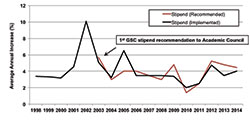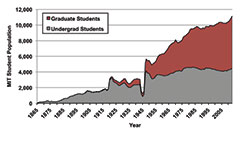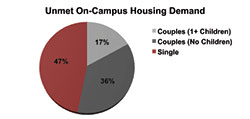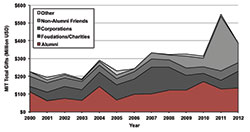
| Vol.
XXVI No.
4 March / April 2014 |
| contents |
| Printable Version |
One Investment Worth Making:
Graduate Student Housing
Introduction
With recent conversations surrounding the Graduate Housing Working Group and East Campus Steering Committee, we are grateful for the opportunity to share what we see as primary drivers affecting graduate student living standards and how those drivers may impact graduate students’ place in the MIT campus of the future. In doing so we recognize the history of constructive dialogue between student leadership and the administration in addressing numerous challenges including health insurance, student life spaces, childcare, dental insurance, and housing to name a few. While our needs are but some of many considerations in the broader context of campus planning and renewal, budget constraints, and the upcoming capital campaign, we present a case for the value of graduate students as an integral part of the MIT campus community and for one investment we feel is worth making.
Graduate Student Living Costs and Annual Stipend Increase
Since 2003, the Graduate Student Council (GSC) has partnered with the Office of the Dean for Graduate Education to analyze graduate student living costs. Each year we present an analysis to Dean’s Group along with recommendations for an average stipend increase. In addition to the GSC recommendation, Dean’s Group also takes into consideration future funding source availability, equity with faculty, staff, and post-doc wage increases, and MIT’s ability to compete for top talent with peer institutions.
The guiding principle behind the GSC stipend recommendation is to maintain existing graduate student standards of living accounting for expenditures and inflation.
We determine expenditures using a cost of living survey conducted in collaboration with the MIT Office of Institutional Research in the Office of the Provost. Aggregate inflation is determined using regional inflation rates for non-housing expenditures as given by the U.S. Consumer Price Index. Housing inflation is estimated using MIT Off-Campus Housing Office and Cambridge Community Development Department (CDD) data on average asking rents in the micro-regions in Cambridge and Somerville where most graduate students reside. The historic implemented and GSC recommended average annual stipend increase is given in Figure 1. Since 2003, the average GSC recommended and implemented stipend increases have been 3.9% and 3.8% respectively.

(click on image to enlarge)
Off-Campus Rent Inflation as the Primary Driver
MIT graduate students today on average spend 53% of their stipend on housing, an increasing trend from 47% in 2003. With approximately 60% of students living off campus in recent years, off-campus housing rent increases are the largest inflation driver. From 2000 to 2010, Cambridge rent increases trended between 2-3 percent; however, since 2011 we have seen a significant rise in Cambridge rent inflation compared to stipend increases (see Figure 2).

2000-2010 and 2011-2014
(click on image to enlarge)
One of our primary concerns is that recent off-campus rent inflation in the areas students reside is unsustainable compared to recent stipend increases. Future commercial developments around Kendall Square, some of which have been identified by MITIMCo (MIT Investment Management Company) as valuable investment opportunities, are expected to generate additional demand for near-campus housing. As these developments come online, higher wage earners are likely to outprice graduate students and post-docs for limited housing stock. In addition, current market-based housing projects in Cambridge focus almost exclusively on luxury apartments and condo conversion is expanding (the conversion of low-priced housing stock into higher priced condos). Under these conditions it is unlikely that students will be able to depend entirely on the market to provide affordable housing near campus as we have in the past. If unresolved, it is likely that off-campus housing pressures will push graduate students to live further from campus.
Impact on Graduate Families
While growing competition in the Cambridge housing market impacts all graduate students, the growth disproportionally affects graduate student families. Single students and post-docs often share multi-bedroom low-priced units and are able to outprice families through their combined purchasing power. Whereas the median asking price for an apartment in Cambridge is $2,500 for a one-bedroom and $3,000 for a two-bedroom unit [Cambridge Community Development Department Housing Profile Report], the most inexpensive one- and two-bedroom units for families on campus are $1,421 and $1,640 respectively. Cost, therefore, is a major driver for on-campus family housing demand. Recently, the Graduate Housing Working Group recommended 500-600 new on-campus beds based on current unmet demand (as well as an additional 400 beds of swing space to accommodate renewal of existing housing stock). While graduate families are a smaller segment of the overall student population they constitute the majority of current unmet demand (see Figure 3).
| Back to top |
Investment and Community
This year the average graduate RA, TA, or fellowship award was approximately $75,000 [Based on tuition, medical insurance, and an average stipend of $29,800]. In addition, MIT provided $226 million in tuition support [2013 MIT Report of the Treasurer]. Factoring in existing subsidies for graduate housing – as much as $12,000 per bed as Chairman Reed indicated in the last Faculty Newsletter – MIT paid around $256 million in graduate tuition support and rent subsidies. Considering all the present budgetary demands – including over $2.5 billion in deferred maintenance – one may ask whether additional on-campus housing is warranted, or whether stipends should increase at a higher rate commensurate with the off-campus housing market.
Regardless the approach, all indicators suggest that any future effort to house graduate students near campus will come at an additional cost. We submit that keeping students near campus is not only worth the cost, but necessary for MIT to fulfill its mission as a vibrant, productive, and inclusive academic community that fosters interdisciplinary collaboration, innovation, and entrepreneurship.
On a related note, the Graduate Housing Working Group report spoke briefly on the relation between graduate students and the upcoming capital campaign. In recent history, alumni have been the primary and most consistent source of philanthropic gifts to the Institute (see Figure 4). In 2012, graduates surpassed undergraduates as the majority of all living alumni, a shift that will continue to grow based on historic (see Figure 5) and projected student body populations. As a result, MIT’s approach to alumni engagement and philanthropic gift giving will need to respond accordingly.

(click on image to enlarge)
Recent analytics and market research indicate that the likelihood of alumni to give to MIT is based primarily on affinity, or a sense of belonging to the MIT community, and affinity can be highly influenced by a student’s level of engagement in extracurricular, club, sport, social and other activities outside of academics and research. To the extent that on-campus housing can play a vital role in building community and creating a sense of affinity, we submit that on-campus housing should not be viewed as an additional cost or subsidy but rather as one investment worth making. An investment that, in the face of current financial pressures, prioritizes graduate students as an integral part of the MIT community, not only in the limited view of graduate students as future alumni that will pave the way for MIT’s financial future, but an investment in the community of current students whose constant on-campus presence is at the heart of what uniquely drives MIT as a global leader in science, engineering, innovation, and entrepreneurship.
While the costs of an increasingly disparate graduate student body may be difficult to quantify, we strongly feel the impact will be real. How does one gauge the value of late night Energy Club lectures, collaborations at the Trust Center, GSC multicultural events at Morss Hall, and after work drinks at the Muddy Charles Pub in driving MIT’s inclusive and collaborative ecosystem? How will the frequency and accessibility of those interactions be impacted by an increasingly dispersed graduate student body pushed apart by the economic strains of a competitive housing market? What message are we sending to students about their place in the MIT community if development decisions prioritize commercial development on and near campus while at the same time housing costs are pushing graduate students further away?
We express our deepest gratitude to the administration for engaging us this year in the Graduate Housing Working Group and East Campus Steering Committee and appreciate the constructive dialogue we have had in addressing these demanding issues. While we understand there are no simple answers to the challenges presented, we look forward to continuing the conversation as we work together to make MIT a better place.
Authors:
Caleb Waugh is a fifth-year graduate student in Nuclear Science and Engineering, President of the Graduate Student Council and member of the East Campus Steering Committee.
Charlotte Seid is a fourth-year graduate student in Biology and a member of the Graduate Housing Working Group.
Marzyeh Ghassemi is a second-year graduate student in Electrical Engineering and Computer Science and Co-Chair of the GSC Committee on Housing and Community Affairs.
Andrea Dubin is a third-year graduate student in Earth Atmospheric and Planetary Sciences, Co-Chair of the GSC Committee on Housing and Community Affairs, and a member of the Graduate Housing Working Group.
| Back to top | |
| Send your comments |
| home this issue archives editorial board contact us faculty website |

